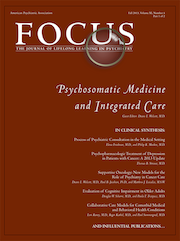Highlights of Changes from DSM-IV to DSM-5: Somatic Symptom and Related Disorders
Abstract
Somatic Symptom Disorder
| A. One or more somatic symptoms that are distressing or result in significant disruption of daily life. |
| B. Excessive thoughts, feelings, or behaviors related to the somatic symptoms or associated health concerns as manifested by at least one of the following: |
| 1. Disproportionate and persistent thoughts about the seriousness of one’s symptoms. |
| 2. Persistently high level of anxiety about health or symptoms. |
| 3. Excessive time and energy devoted to these symptoms or health concerns. |
| C. Although any one somatic symptom may not be continuously present, the state of being symptomatic is persistent (typically more than 6 months). |
| Specify if: |
| • With predominant pain (previously pain disorder): This specifier is for individuals whose somatic symptoms predominantly involve pain. |
| Specify if: |
| • Persistent: A persistent course is characterized by severe symptoms, marked impairment, and long duration (more than 6 months). |
| Specify current severity: |
| • Mild: Only one of the symptoms specified in Criterion B is fulfilled. |
| • Moderate: Two or more of the symptoms specified in Criterion B are fulfilled. |
| • Severe: Two or more of the symptoms specified in Criterion B are fulfilled, plus there are multiple somatic complaints (or one very severe somatic symptom). |
Medically Unexplained Symptoms
Hypochondriasis and Illness Anxiety Disorder
Pain Disorder
Psychological Factors Affecting Other Medical Conditions and Factitious Disorder
| A. A medical symptom or condition (other than a mental disorder) is present. |
| B. Psychological or behavioral factors adversely affect the medical condition in one of the following ways: |
| 1. The factors have influenced the course of the medical condition as shown by a close temporal association between the psychological factors and the development or exacerbation of, or delayed recovery from, the medical condition. |
| 2. The factors interfere with the treatment of the medical condition (e.g., poor adherence). |
| 3. The factors constitute additional well-established health risks for the individual. |
| 4. The factors influence the underlying pathophysiology, precipitating or exacerbating symptoms or necessitating medical attention. |
| C. The psychological and behavioral factors in Criterion B are not better explained by another mental disorder (e.g., panic disorder, major depressive disorder, posttraumatic stress disorder). |
| Specify current severity: |
| • Mild: Increases medical risk (e.g., inconsistent adherence with antihypertension treatment). |
| • Moderate: Aggravates underlying medical condition (e.g., anxiety aggravating asthma). |
| • Severe: Results in medical hospitalization or emergency room visit. |
| • Extreme: Results in severe, life-threatening risk (e.g., ignoring heart attack symptoms). |
Conversion Disorder (Functional Neurological Symptom Disorder)
Promoting Holistic Care
Information & Authors
Information
Published In
History
Authors
Metrics & Citations
Metrics
Citations
Export Citations
If you have the appropriate software installed, you can download article citation data to the citation manager of your choice. Simply select your manager software from the list below and click Download.
For more information or tips please see 'Downloading to a citation manager' in the Help menu.
View Options
View options
PDF/EPUB
View PDF/EPUBGet Access
Login options
Already a subscriber? Access your subscription through your login credentials or your institution for full access to this article.
Personal login Institutional Login Open Athens loginNot a subscriber?
PsychiatryOnline subscription options offer access to the DSM-5-TR® library, books, journals, CME, and patient resources. This all-in-one virtual library provides psychiatrists and mental health professionals with key resources for diagnosis, treatment, research, and professional development.
Need more help? PsychiatryOnline Customer Service may be reached by emailing [email protected] or by calling 800-368-5777 (in the U.S.) or 703-907-7322 (outside the U.S.).

